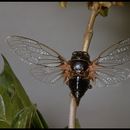en
names in breadcrumbs


Okanagana occidentalis is known from Arizona, California, Colorado, Idaho, Montana, Nevada, New Mexico, Oregon, Utah, Washington, and Wyoming (U.S.A.) and British Columbia and Alberta (Canada). It can be found in large numbers in sagebrush shrublands in Colorado. It has been associated with cottonwoods (Populus spp.), trees, underbrush, and flowers. Sanborn & Phillips found it associated with several bushy plants in a wash. It is restricted to mountainous environments and is associated with the Rocky Mountain forests, intermountain forests, Pacific coastal/Cascadian forests, and California forests. (Sanborn & Phillips 2013)
Okanagana occidentalis is a species of cicada in the family Cicadidae.[1][2][3][4] It is found in North America.[1]
Okanagana occidentalis is a species of cicada in the family Cicadidae. It is found in North America.